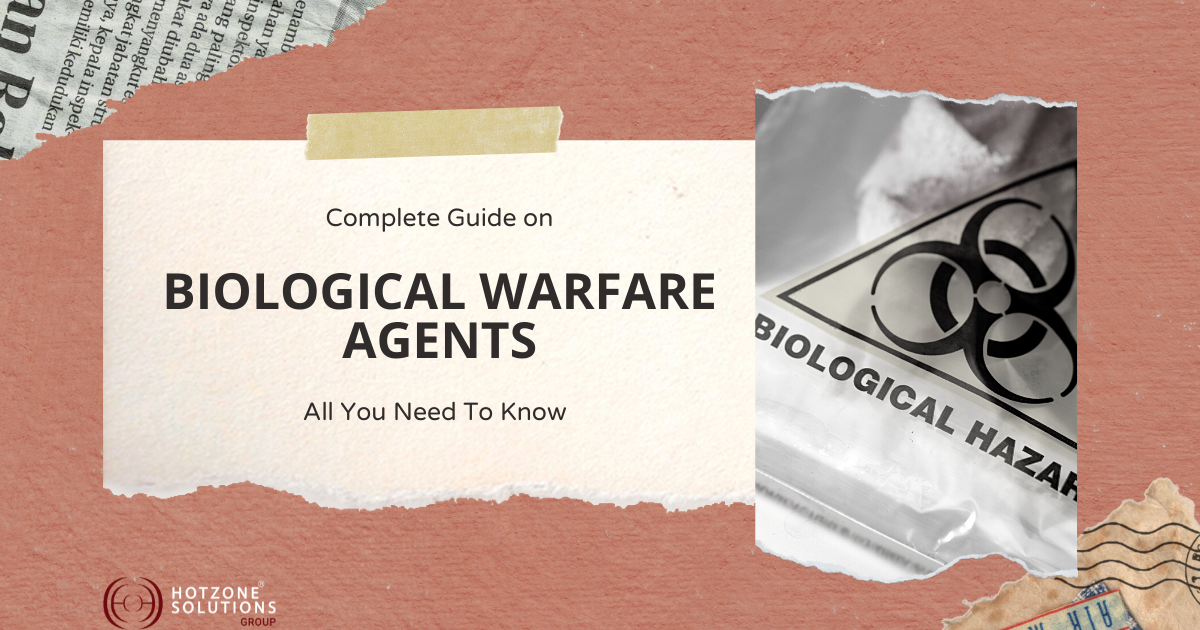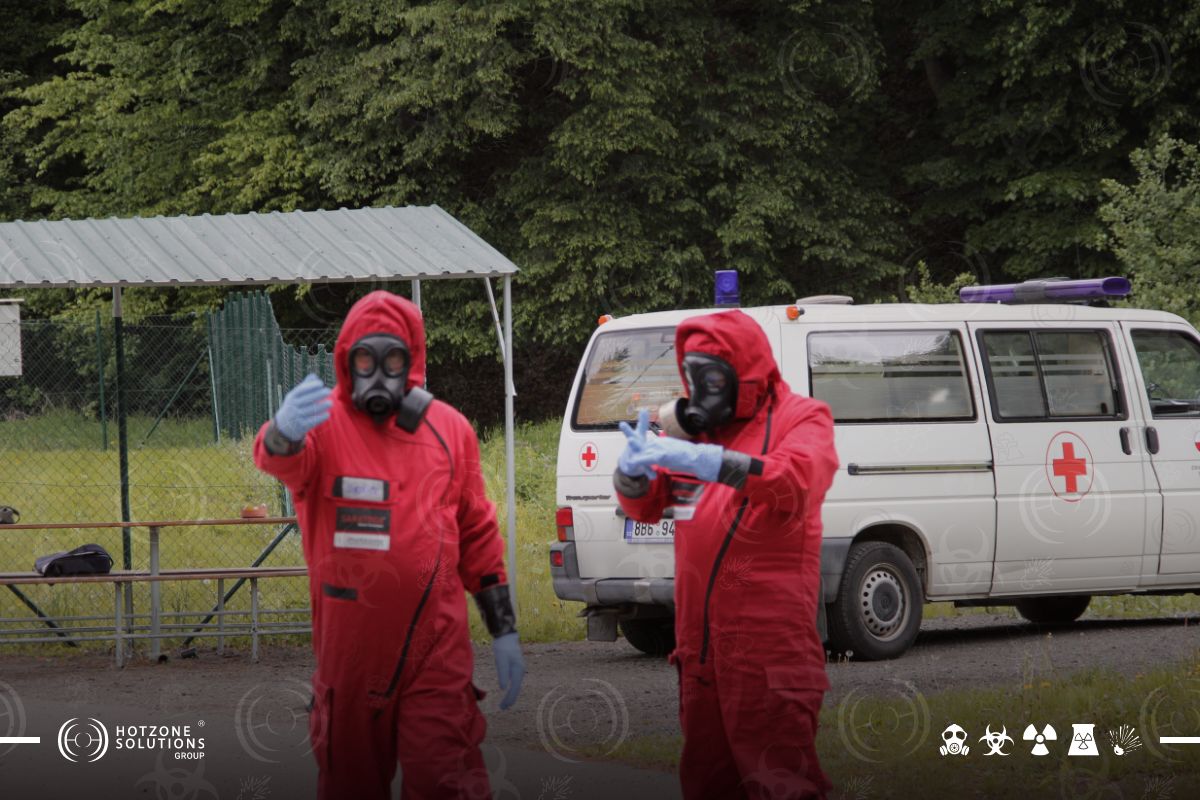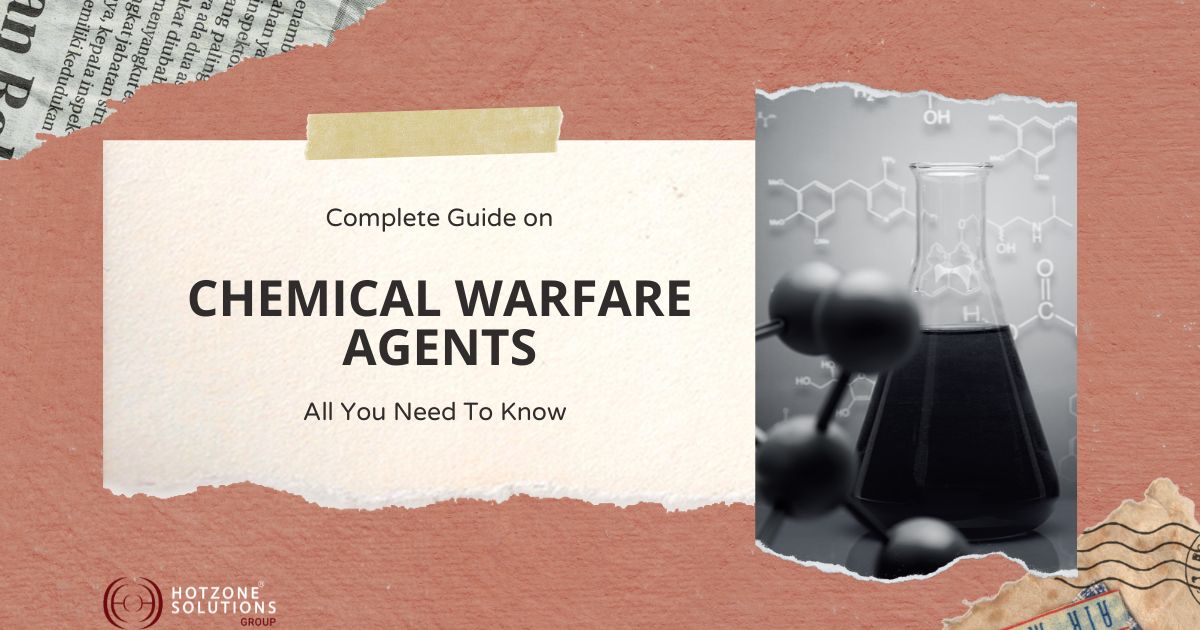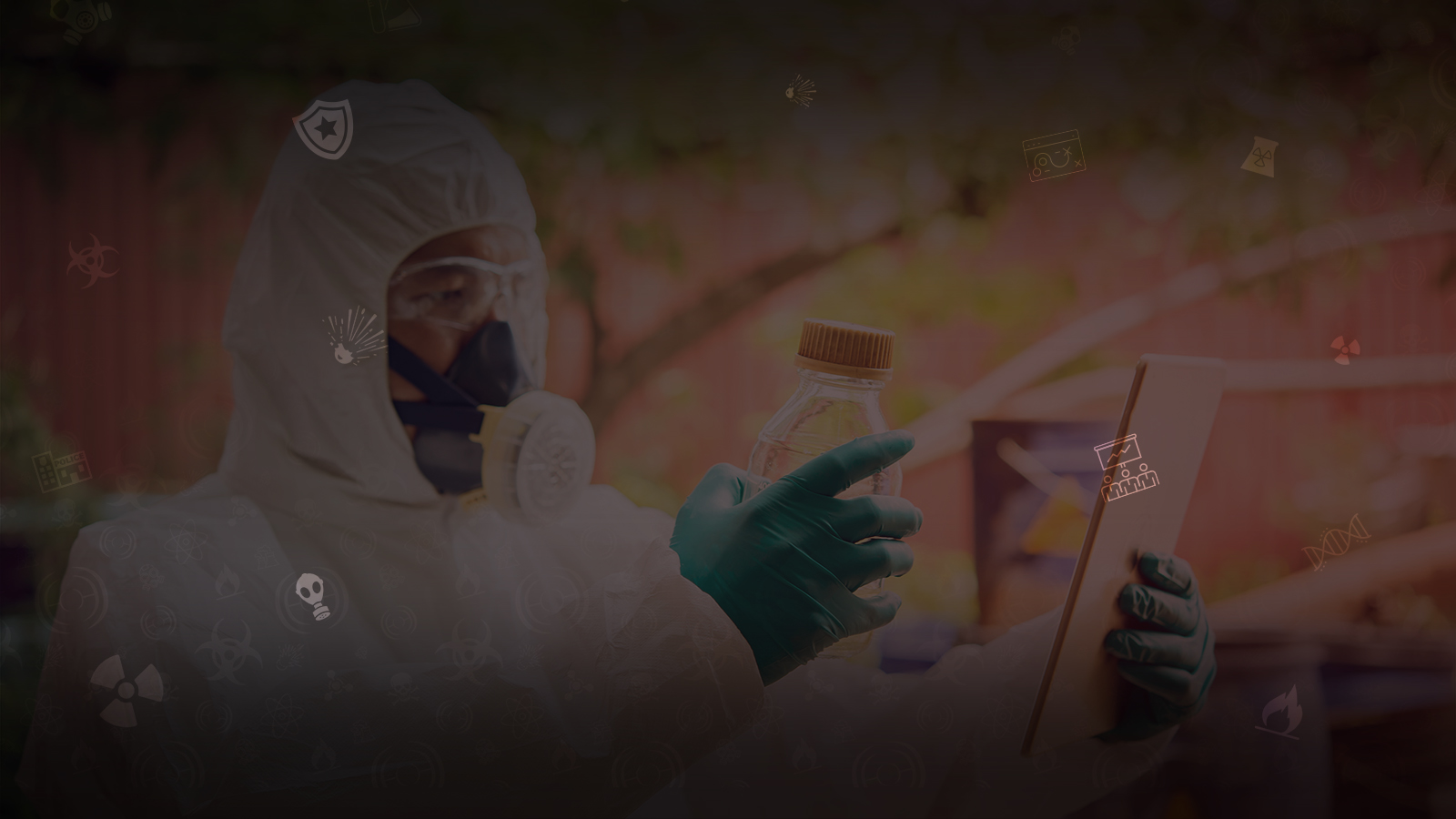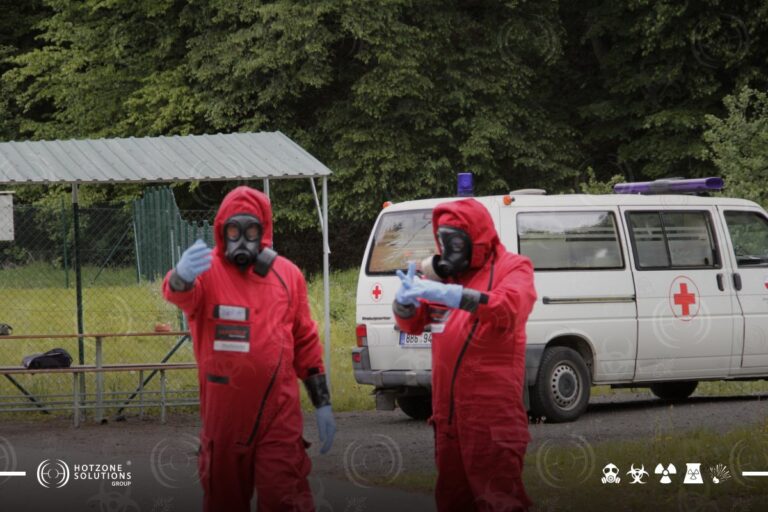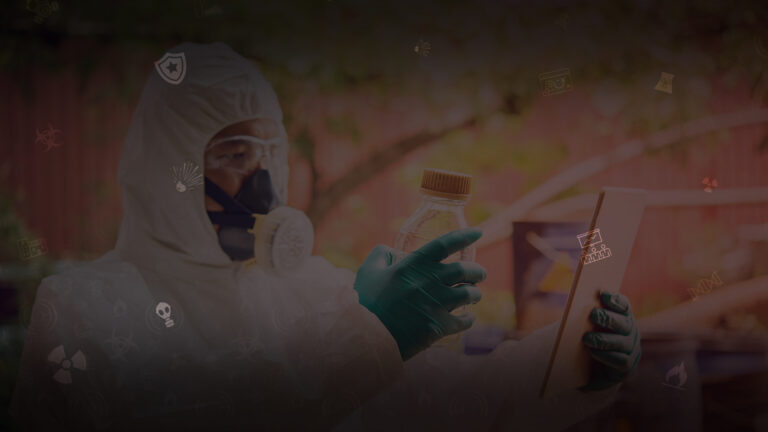People need to be aware of biological warfare agents and the risks they pose, as well as the measures that can be taken to protect against them. While the use of these agents as weapons is banned by international treaties there is still a risk that they could be used by terrorists or rogue states.
Governments and public health organizations need to be prepared to detect and respond to a biological attack, to minimize the impact on public health and safety.
What Are Biological Warfare Agents?
Biological warfare agents are disease-causing living organisms or toxins that can be used to harm or kill humans, animals or plants.
Some examples of biological warfare agents include:
- Bacteria, such as anthrax and bubonic plague
- Viruses, such as Ebola and smallpox
- Toxins produced by living organisms, such as botulinum toxin and ricin
- other biological warfare agents (e.g. fungi, prions or rickettsiae, etc.).
These agents can be disseminated, among other, through the air, water, or food. Also, they can be spread by direct contact with an infected person or animal.
International treaties banned the use of biological warfare agents as weapons, and it is considered a war crime to use them in armed conflict. However, there is still a risk that they could be used by terrorists or rogue states.
History of Biological Warfare Agents Use
The use of biological agents as weapons has a long history, dating back to ancient times.
“Biological warfare has a long history, dating back to ancient times, when the Assyrians poisoned enemy wells with rye ergot, a fungus that causes hallucinations and death”
Ackerman, G. & Moran, M.
Antiquity & Middle Ages
- 6th century BC: Perhaps one of the earliest reported and most simple uses of a biological agent in warfare is from the 6th century BC, when Assyrian armies used a toxin derived from ergot-infected rye to poison the water wells of besieged enemies.
- 400 BC: Another unique and innovative use of biological agents is reported from around 400 BC, in which it was the practice of Scythian archers to dip the heads of their arrows into vats of bacteria-rich human excrement and decomposing corpses.
- In the Middle Ages: the Tartars threw the bodies of plague victims over the walls of the besieged city of Kaffa in an attempt to spread the disease.
- 16th century: In Africa, biological agents such as poisoned arrows and powders were used, as well as the poisoning of horses and water supplies.
- The Great Northern War: Russians under the leadership of Peter the Great exploited the same “biological pathogen” delivery methods that the Tartars used, catapulting plague-infected corpses, against the Swedes.
18th to 19th century
- June 1763: During the French and Indian War, it is reported that the commander of Fort Pitt ordered his men to give smallpox-infested blankets to a Native American delegation during a siege.
- This resulted in an outbreak of smallpox that killed number of Native Americans. It is unclear whether the smallpox was a result of this incident or whether the virus was already present among the Native American population.
- During the American Revolutionary War: there were rumors that the British tried to spread smallpox to American lines by sending civilians out of the city during the Siege of Boston. However, these rumors were not substantiated.
- In 1789: Some historians have also claimed that smallpox was deliberately used by a detachment of the Corps of Royal Marines in Australia.
World War I
- By the early 20th century, advances in science had led to a greater understanding of the potential use of biological agents in warfare.
- During World War I, the Imperial German government is reported to have carried out biological sabotage using anthrax and glanders, but with little success. The Geneva Protocol of 1925 was established to prohibit the use of chemical and biological weapons.
World War II
During World War II, Japan’s Unit 731 conducted experiments on prisoners of war, testing the effects of biological warfare agents such as anthrax and bubonic plague.
Williams, P.
- During World War II, the United Kingdom established a biological warfare program at Porton Down and successfully weaponized several agents, including tularemia, anthrax, brucellosis, and botulism toxins.
- The United States also established a large research program and industrial complex at Fort Detrick and conducted tests at the Dugway Proving Grounds in Utah.
- Japan’s Imperial Army Unit 731 conducted human experiments and produced biological weapons for combat use, often targeting Chinese soldiers and civilians with diseases such as the bubonic plague.
- There were also plans to use plague as a weapon against U.S. civilians in California, but the attack was never carried out due to Japan’s surrender.
Cold War
In the Cold War era, the United States and the Soviet Union both developed large stockpiles of biological warfare agents, raising concerns about the potential for accidental release or unauthorized use
Zilinskas, R.
- In the 1950s, the United Kingdom developed weaponized versions of plague, brucellosis, tularemia, and equine encephalomyelitis and vaccinia viruses, but the program was ended in 1956. The United States also developed weaponized versions of anthrax, tularemia, brucellosis, and Q-fever.
- In 1969, President Nixon ended the offensive biological weapons program of the US, allowing only research for defensive purposes.
- This decision led to negotiations for a ban on biological warfare, which resulted in the signing of the Biological Weapons Convention (BWC) in 1972 and its entry into force in 1975.
- Despite being a party to the BWC, the Soviet Union allegedly continued and expanded its biological weapons program under the leadership of the institution Biopreparat.
- The Soviet Union faced international suspicion following the 1979 Sverdlovsk anthrax leak, which killed approximately 65 to 100 people.
The Biological and Toxin Weapons Convention (BTWC) prohibits the development, production, acquisition, stockpiling, retention, transfer or use of biological weapons, and it is enforced by 162 state parties, however, the continued existence of a number of potential and actual violators underlines the challenges of enforcement
Kellman, B.
Types of Biological Warfare Agents
There are many different types of biological warfare agents, including bacteria, viruses, fungi, prions, rickettsia, and toxins produced by living organisms.
“Bacteria have been used as biological warfare agents for centuries, with the earliest recorded use dating back to the 14th century, when the Tatars used plague-infested corpses to infect the Mongol army”
Kelly, D.M.
Some specific examples of biological warfare agents (biological pathogens identified as likely to have been weaponized and/or used as biological terrorism threat agents) include:
Bacteria:
- Anthrax
- Bubonic plague
- Cholera
- Tularemia
Viruses:
- Ebola
- Marburg virus
- Smallpox
- Yellow fever
Toxins (some covered by CWC also):
- Botulinum toxin
- Ricin
- Staphylococcal enterotoxin B
- T-2 toxin
Bacterial Biological Warfare Agents
Bacterial biological warfare agents are types of bacteria that can be used as weapons to kill or incapacitate people, livestock, or crops. Some examples of bacterial biological warfare agents include:
Anthrax
A bacterial infection that can be transmitted to humans, among others, through skin contact with infected animals or inhalation of spores. The pathogenic bacterium is Bacillus anthracis and it is considered a Category A potential biological terrorism agent.
“Anthrax is a highly effective biological warfare agent because of its stability, ease of production and dissemination, and ability to cause severe disease.”
Inglesby, T.V., Henderson, D.A., Bartlett, J.G., et al.
Symptoms of anthrax infection can include:
- fever
- fatigue
- confusion or dizziness
- skin rash that turns into painful sores.
In severe cases, anthrax can lead to life-threatening complications and severe symptoms, breathing difficulties, shock, and eventually death if not treated.
Bubonic plague
Bubonic plague is a bacterial infection that is transmitted to humans, mostly through the bites of infected fleas. The pathogenic bacterium is Bacillus Y. pestis, and it is considered a Category A potential biological terrorism agent.
“During the 14th century, the Tartars used the bubonic plague as a biological weapon by catapulting the bodies of plague victims over the walls of the besieged city of Kaffa”
Henderson, D.A.
Symptoms of bubonic plague include:
- fever
- chills
- weakness
- swollen lymph nodes.
If left untreated, bubonic plague can progress to a more severe form called pneumonic plague, which can be spread from person to person through the air. Untreated pneumonic plague, if not diagnosed and treated early, can be fatal.
Cholera
Cholera is an acute infectious disease caused by ingestion of food or water contaminated with the bacterium Vibrio cholerae. It has ability to spread quickly in areas with inadequate sanitation.
“Cholera was used as a weapon of biological warfare by the Imperial Japanese Army during World War II, where they dropped infected fleas over Chinese cities”
Alibek, K.
Symptoms of cholera include:
- severe diarrhea “rice-water stools”
- vomiting
- dehydration
- leg cramps
- dry and shriveled skin
- sunken eyes
Cholera is a serious condition that can have severe consequences if not treated appropriately.
People with cholera may experience a range of complications, including hypoglycemia, hypotension, and low potassium levels.
If left untreated, cholera can lead to shock from dehydration, kidney failure, coma, and death.
Tularemia
A bacterial infection that is transmitted through, among others, contact with infected animals or through inhalation of bacteria, or ingestion. The pathogenic bacterium is Francisella tularensis, and it is considered a Category A potential biological threat agent.
“Tularemia, also known as rabbit fever or deer fly fever, is considered a potential biological warfare agent due to its high infectivity and ability to cause severe illness or death”
Plague as a Biological Weapon
Symptoms of tularemia can include:
- fever
- weakness
- diarrhea
- muscle aches
- joint pain
- dry cough
- sore throat.
F. tularensis is considered a likely agent for bioterrorism because it can easily be aerosolized to enhance inhalation exposure, and an infective dose may be as few as 10–50 bacteria.
In severe cases, tularemia can lead to life-threatening complications, such as pneumonia, chest pain, bloody sputum, difficulty breathing, systemic infection, and death.
“The development of antibiotic resistance in common bacterial pathogens such as Staphylococcus aureus and Escherichia coli has raised concerns about the potential for these organisms to be used as biological warfare agents”
Chen, L.
Viral Biological Warfare Agents
Viral biological warfare agents are types of viruses that can be used as weapons to kill or incapacitate people, livestock, or crops. Some examples of viral biological warfare agents include:
“Viruses have long been seen as attractive agents for biological warfare because of their ability to cause severe disease and spread rapidly”
Dowdle, W. R.
Ebola
A viral illness that is transmitted through contact with the blood or bodily fluids of an infected person. It causes viral hemorrhagic fever (VHF) in humans and other primates and is classified as Category A biological threat agents.
“The Ebola virus has been considered as a potential biological weapon due to its high mortality rate and ability to spread easily through human-to-human transmission”
Gostin, L.O.
Symptoms of Ebola can include:
- fever
- weakness
- muscle pain
- vomiting.
In severe cases, Ebola can lead to life-threatening complications, such as bleeding, organ failure, and death where the patient dies in hypovolemic shock or a coma.
Severe pulmonary hemorrhage, gastrointestinal hemorrhage, hepatitis, or encephalitis are the causes of death in terminal infections.
Marburg virus
A viral illness similar to Ebola virus that is transmitted through contact with the blood or bodily fluids of an infected person. It is causing viral hemorrhagic fever (VHF) in humans and other primates, and is classified as Category A biological threat agents.
“Marburg virus is a highly virulent and contagious agent that causes severe hemorrhagic fever, which can have a case-fatality rate of up to 25%.”
World Health Organization
Symptoms of Marburg infection can include:
- fever
- headache
- muscle aches
- a rash.
In severe cases, Marburg virus infection can lead to life-threatening complications, such as organ failure, bleeding, and death.
As the disease progresses, the patient’s condition can deteriorate rapidly. The patient may develop severe dehydration, hypotension, hypovolemic shock, and organ failure, which can lead to death.
Smallpox
A viral illness that is transmitted through contact with an infected person or through inhalation of the virus, or ingestion. The virus that causes smallpox, Variola major, is a Category A biological threat agent.
“Smallpox is considered a potential bioterrorism agent due to its high mortality rate, ease of dissemination, and potential for person-to-person transmission”
Plague as a Biological Weapon
Symptoms of smallpox can include:
- high fever
- fatigue
- rash
- abdominal pain
- headache
Over the next 2–3 weeks, the virus continues to damage the body, particularly the immune and circulatory systems.
The case fatality rate for non-hemorrhagic smallpox is approximately 30%, but 2–6% of smallpox infections are classified as hemorrhagic and result in mortality rates of over 95%.
Yellow fever
A viral illness that is transmitted through the bites of infected mosquitoes. The virus that causes yellow fever (belongs to the genus Flavivirus), is a Category C biological threat agent.
“Yellow fever was weaponized in the early 20th century by the US, Japan and Germany, with the goal to develop it as a biological weapon against their enemies”
Alibek, K.
Symptoms of yellow fever can include:
- fever
- headache
- muscle aches
- severe liver disease with bleeding and yellowing skin (jaundice).
In severe cases, the infection spreads throughout the body and can cause organ failure.
The patient may also develop sepsis and encephalitis, which is inflammation of the brain, can occur and lead to confusion, delirium, seizures, and even coma. In the most severe cases, yellow fever can be fatal.
Toxins as Biological Warfare Agents
Toxins are substances produced or derived from living organisms, both animal and plant, such as bacteria, cyanobacteria, fungi, and some species of plants and marine fish, that cause disease pathology or other debilitating response in humans and other animals, and that can be used as weapons.
Next to the BWC, the Chemical Weapons Convention (CWC) covers some toxins as CWA also. Here are some examples of toxins:
Botulinum toxin
A toxin produced by the bacterium Clostridium botulinum. It is one of the most toxic substances known to man, is considered a Category A biological threat agent.
Botulinum toxin can be, among others, ingested or inhaled, and it can also be injected directly into the body.
“Botulinum toxin is a highly toxic substance that can be used as a biological weapon. It is produced by the bacterium Clostridium botulinum and can cause severe muscle paralysis and death.”
Centers for Disease Control and Prevention
Symptoms of botulism typically appear within 12 to 36 hours after exposure, but can take up to several days to appear. The symptoms of botulism can include:
- fatigue
- weakness
- dizziness
- dry mouth
- difficulty swallowing
- double vision or blurred vision
- drooping eyelids
- dlurred speech
- difficulty breathing
It can cause life-threatening paralysis of breathing muscles and the diaphragm.
Ricin
A toxin (named Phytotoxalbumin) produced by the castor oil plant (Ricinus Communis). It is considered a Category B toxin that could likely be used as a biological threat agent for bioterrorism.
It can be ingested, inhaled, or injected into the body.
“Ricin is a highly toxic protein that can be used as a biological warfare agent. When inhaled, ingested, or injected, it can cause severe respiratory problems, organ failure, and death”
Centers for Disease Control and Prevention
Symptoms of ricin poisoning can vary depending on the method of exposure, but some common symptoms include:
- nausea, vomiting, and diarrhea (if ingested)
- difficulty breathing, coughing, and chest tightness (if inhaled)
- severe abdominal pain and seizures
- high fever, sweating, and low blood pressure
- blurred vision and confusion
- organ failure
In severe cases, it can cause death within 36 to 72 hours from the time of exposure.
Staphylococcal enterotoxin B
A toxin produced by the bacterium Staphylococcus aureus, and is classified as a Category B biological threat agent. It can be inhaled or ingested.
“SEB is one of the most toxic members of the staphylococcal enterotoxin family and has been classified as a potential biological warfare agent by the United States government.”
Eitzen, E. M., & Cote, C. K.
Symptoms of staphylococcal enterotoxin B poisoning include:
- severe gastrointestinal (GI) pain
- projectile vomiting
- diarrhea
- muscle aches
- fever and chills
- shortness of breath when inhaled.
In severe cases and exposure to excessive doses can lead to septic shock and death if untreated.
T-2 toxin
A toxin produced by the fungus Fusarium Sporotrichioides and can be used in bioterrorism. It can be ingested or inhaled, or delivered through the skin.
“T-2 toxin is a trichothecene mycotoxin, which was extensively used as a biological warfare agent during World War II by the Japanese army”
Mirocha, C.J., et al.
Symptoms of T-2 toxin exposure vary depending on the dose and duration of exposure, but they can include:
- Gastrointestinal symptoms: Nausea, vomiting, diarrhea, abdominal pain, and loss of appetite
- Respiratory symptoms: Coughing, difficulty breathing, and chest tightness
- Dermal symptoms: Skin irritation, rash, and itching.
In severe cases, T-2 toxin can lead to organ failure and death.
Biological Warfare Agents Types by Target
Biological warfare agents can be categorized by the type of organism or toxin used, and also by the target they are designed to affect, as well as according to their lethality and their transmissibility. Here are some examples of common types of biological warfare agents grouped by target:
“Biological warfare agents can be divided into three main categories: those that target humans, those that target animals, and those that target plants”
Smyth, A.
- Human pathogens: These include bacteria, viruses, and other microorganisms that can cause disease in humans. Examples include anthrax, smallpox, and plague.
- Animal pathogens: These include microorganisms that can cause disease in animals. Examples include foot-and-mouth disease and avian influenza.
- Plant pathogens: These include microorganisms that can cause disease in plants. Examples include rice blast fungus and wheat stem rust.
It’s important to note that some agents can target multiple types of organisms, for example anthrax can infect both humans and animals, and toxins like ricin can be used to target both animals and humans. It is also worth noting that the effects of biological warfare agents can depend on a variety of factors, including the type and dose of the agent, the method of exposure (e.g., inhalation, ingestion, injection), and the individual characteristics of the person or organism exposed (e.g., age, health status).
What is Bioterrorism?
Bioterrorism is the intentional release of biological agents (such as bacteria, viruses, or toxins) to cause illness or death in people, animals, or plants.
“Bioterrorism attacks can be difficult to detect and respond to because the symptoms of a biological agent may not appear for days or even weeks after exposure”
Centers for Disease Control and Prevention
These agents can be naturally occurring or genetically modified to increase their virulence (ability to cause disease) or resistance to treatment.
Bioterrorism can be carried out by individuals, groups, or governments, and can have significant impacts on public health and national security.
The threat of bioterrorism has increased in recent years due to the ease of access to information about how to produce and disseminate some biological agents, and the potential for these agents to be used as weapons of mass destruction.
Which Biological Agent can be Used in Bioterrorism?
Biological agents that could potentially be used in bioterrorism include bacteria, viruses, fungi, and toxins produced by these microorganisms.
Some examples include:
- anthrax
- plague
- smallpox
- botulinum toxin
- tularemia
- ebola virus.
It is important to note that the use of any of these agents in a bioterrorism attack would have severe consequences and is considered a grave threat to public health and national security.
Detection and Identification of Biological Warfare Agents
Several methods can be used to detect and/or identify biological warfare agents, including:
“Detection of biological warfare agents is challenging due to the wide variety of pathogens that can be used as weapons and the difficulty in distinguishing between natural outbreaks and deliberate attacks”
Pitt, L.
Sampling and laboratory analysis
Samples of air, water, soil, tissue or other materials can be collected and analyzed in a laboratory to identify the presence of biological agents.
This can be done using techniques such as PCR (polymerase chain reaction), which amplifies small amounts of DNA or RNA to make it easier to detect, or ELISA (enzyme-linked immunosorbent assay), which uses antibodies to detect the presence of specific proteins or antigens.
Biosensors
Devices that can detect the presence of biological agents in real time. Some biosensors use genetic material from the agent to detect its presence, while others use antibodies or other proteins to identify specific agents. Such are antibody-based sticks or hand-held assays (HHA).
Physical and chemical methods
They detect the presence of biological agents without the need for laboratory analysis (which still would be needed for identification).
For example, biological agents can often be detected using ultraviolet light, because they fluoresce or emit light when exposed to UV light.
Specific ATP bioluminescence is one such non-specific detection method.
Other physical and chemical methods include:
- Colourimetric assays, which use a chemical reaction to change the colour of a solution in the presence of a biological agent.
- Mass spectrometry, which can identify the presence of specific biological molecules based on their mass
- Raman spectroscopy, or aerosol bio detector using fluorescence
It is worth noting that detecting biological warfare agents can be challenging, as many agents are difficult to detect due to their small size or their presence in low concentrations.
In addition, some agents are difficult to distinguish from naturally occurring organisms or toxins, which can make detection more challenging.
Other problems in biodetection and identification come from the complexity of bio agents (compared to chemical agents), mutations that can dramatically change virulence and unknown or new bio agents.
Protection against Biological Warfare Agents
“Effective protection against biological warfare agents requires a combination of vaccination, prophylactic drugs, and decontamination measures”
Alibek, K.
Several measures can be taken to protect against biological warfare agents, including:
Personal protective equipment (PPE)
This includes clothing and equipment that can help to protect the skin, eyes, an respiratory system from exposure to biological agents. Examples of PPE include gloves, goggles, masks, and suits.
Immunizations
Some biological agents can be prevented or treated with vaccines and/or serums. For example, vaccines are available for smallpox, anthrax, and some types of influenza.
Antiviral medications
These drugs can be used to treat viral infections caused by biological agents. For example, antiviral medications can be used to treat Ebola and some types of influenza.
Antibiotics
These drugs can be used to treat bacterial infections caused by biological agents. For example, antibiotics can be used to treat anthrax and plague.
Decontamination of Biological Warfare Agents
After exposure to a biological agent, it is important to decontaminate any affected areas or objects to prevent further exposure. This can be done using a variety of methods including:
- washing with soap and water
- using disinfectants
- heating to high temperatures.
It is worth noting that the effectiveness of these measures depends on the specific biological agent and the circumstances of the exposure. Some agents may not be preventable with vaccines or treatable with medications, and some decontamination protocols may not be fully effective against all agents.
Which Biological Agent Inspires the most Fear?
It is difficult to say which biological agent inspires the most fear, as people’s perceptions of what is most frightening can vary widely.
Some people may be more afraid of infectious diseases that are highly contagious and can spread rapidly, while others may be more afraid of diseases that have high mortality rates or that have no known cure.
Additionally, people may be more afraid of biological agents that have been used in the past as weapons of warfare or terrorism, or that have been depicted in popular media.
Some examples of biological agents that have inspired fear in the past include:
Smallpox
Smallpox is a highly contagious and often deadly infectious disease caused by the variola virus. It was responsible for countless epidemics and is estimated to have killed 300-500 million people in the recent centuries alone.
Smallpox has been used in the past as a biological weapon, and the fear of a smallpox outbreak has been used as a justification for vaccination campaigns and other public health measures.
Smallpox has been eradicated globally through a successful vaccination campaign, and the last naturally occurring case was reported in 1977.
Anthrax
Anthrax is an infectious disease caused by the bacterium Bacillus anthracis. It can be contracted through contact with infected animals, or through inhalation or ingestion of spores.
Anthrax can be used as a biological weapon and has been used in the past for this purpose. The fear of anthrax as a biological weapon has been fueled in part by a series of anthrax attacks that occurred in the United States in 2001, in which envelopes containing anthrax spores were mailed to various individuals.
Important Things to Know about Biological Warfare Agents
- Biological warfare agents are living organisms or toxins that can be used to harm or kill people, animals, or plants. These agents include bacteria, viruses, fungi, and toxins produced by living organisms.
- Biological warfare agents can be transmitted through the air, water, food, via other vectors or they can be delivered directly to the body through skin contact or injection. Some agents can survive for long periods in the environment and can be resistant to some disinfectants and other decontamination methods.
- The symptoms of illness caused by biological warfare agents may not appear for days or weeks after exposure, making it difficult to identify the source of the infection.
- There are limited treatments available for many biological warfare agents, and some agents have no known treatment.
- Biological warfare agents have been used throughout history and are considered a major threat to national and international security. The use of biological warfare agents is prohibited by international law, as outlined in the Biological Weapons Convention.
- It is important to be aware of the risks associated with biological warfare agents and to take appropriate precautions to protect against exposure. This may include using personal protective equipment, getting vaccinated, and practicing good hygiene.
Symptoms of Biological Warfare Agents Attack
The symptoms of illness caused by biological warfare agents can vary depending on the type of agent, the dose, and the route of exposure.
Some common symptoms may include:
- Fever
- Fatigue
- Nausea and vomiting
- Diarrhea
- Abdominal pain
- Chest pain
- Difficulty breathing
- Rash or skin irritation
- Headache
- Muscle and joint aches
It is important to note that the symptoms of illness caused by biological warfare agents may not appear for days or weeks after exposure, making it difficult to identify the source of the infection.
In some cases, the symptoms may be similar to those of a common cold or the flu, making it even more difficult to diagnose.
It is important to seek medical attention if you suspect that you have been exposed to a biological warfare agent.
What to do in Case of a Biological Warfare Agents’ Terrorist Attack?
In the event of a biological warfare agent’s terrorist attack, it is important to follow the instructions of local authorities and emergency responders. They will provide information on the specific steps to take to protect yourself and your family. Here are some general guidelines to follow:
- Stay calm: It is important to stay as calm as possible and not panic. This will help you think clearly and make informed decisions.
- Follow instructions: Local authorities and emergency responders will provide information on the specific steps to take to protect yourself and your family. Follow their instructions carefully.
- Seek shelter: If you are advised to do so, seek shelter in a secure location. Close all windows and doors and turn off ventilation systems to prevent the spread of the agent.
- Protect yourself: If you are advised to do so, wear a mask or other personal protective equipment to protect yourself from inhaling the agent. Practice good hygiene by washing your hands frequently with soap and water and/or skin disinfectant.
- Stay informed: Keep an eye on the news and follow the instructions of local authorities and emergency responders. They will provide updates on the situation and any further steps you should take.
It is also important to be prepared in advance for the possibility of a biological warfare agent’s terrorist attack. This may include keeping a supply of water, non-perishable food, and personal protective equipment on hand in case of an emergency.
Hotzone Solutions Role in Raising Awareness against BWA
Hotzone Solutions is a company that specializes in providing training and equipment for dealing with hazardous materials, including chemical warfare agents (CWAs), Biological Warfare Agents (BWA), and radioactive materiel. We play an important role in raising awareness about the dangers of WMD usage and the need for proper protection and response measures.
Hotzone Solutions offer a variety of training programs for first responders, military personnel, and other individuals who may be at risk of exposure to CBR agents/materiel.
These programs cover topics such as:
- Identification of CWA/BWAs and radioactive materiel
- protective measures
- decontamination, and medical treatment.
We also provide equipment such as protective suits, respirators, and detection instruments that are specifically designed for use in case of CBRN threat.
By providing this training and equipment, Hotzone Solutions helps to ensure that individuals and organizations are prepared to respond effectively to a CBRN threat.
Additionally, by providing awareness, education and training to the public, Hotzone Solutions play an important role in raising public awareness and understanding of the dangers of CBRN threats and the importance of proper protection and response measures.
References
- [1] Ackerman, G. & Moran, M., 2002. “Intentional Plague: The Epidemiology of Biological Warfare”. Emerging Infectious Diseases
- [2] Williams, P., 2002. “Japan’s Biological Warfare 1932-45 and the American Cover-Up”. London: Frank Cass
- [3] – Zilinskas, R., 2005. “Biological Warfare and Disarmament: New Problems, New Perspectives”. Journal of Peace Research.
- [4] – Kellman, B., 2017. “The Biological Weapons Convention: A Framework for Progress”. Journal of Peace Research
- [5] (Kelly, D.M., 2002. “Plague as a biological weapon: past, present, and future”. Microbes and Infection.
- [6] Chen, L., 2003. “Biological warfare and bioterrorism: the need for a comprehensive approach”. Journal of the Royal Society of Medicine.
- [7] Henderson, D.A., 2001. “Plague Wars: The Terrifying Reality of Biological Warfare”. New York: Thomas Dunne Books
- [8] – Smyth, A., et al., 2015. “Biological warfare agents: a historical perspective”. Journal of the Royal Society of Medicine.
- [9] Biohazard: The Chilling True Story of the Largest Covert Biological Weapons Program in the World – Told from Inside by the Man Who Ran It”

